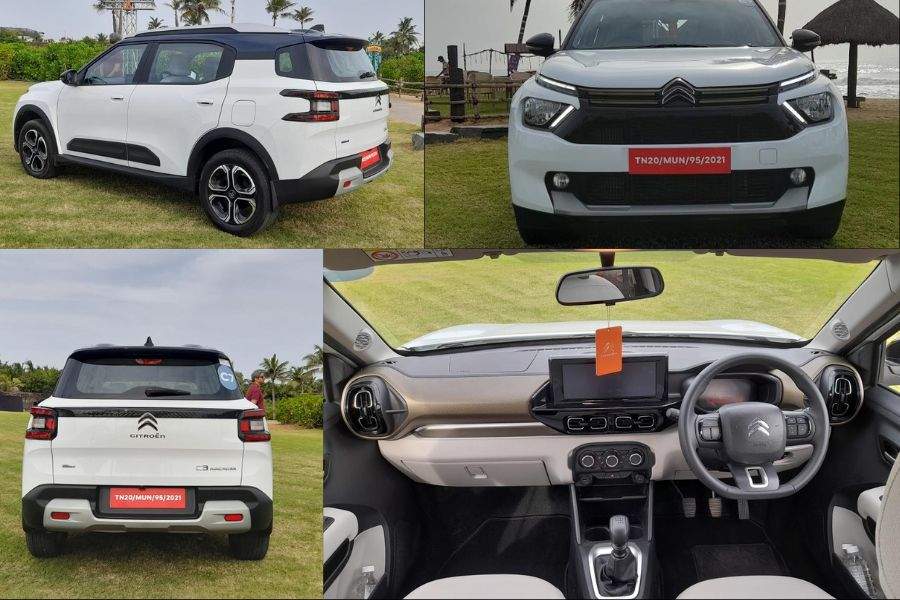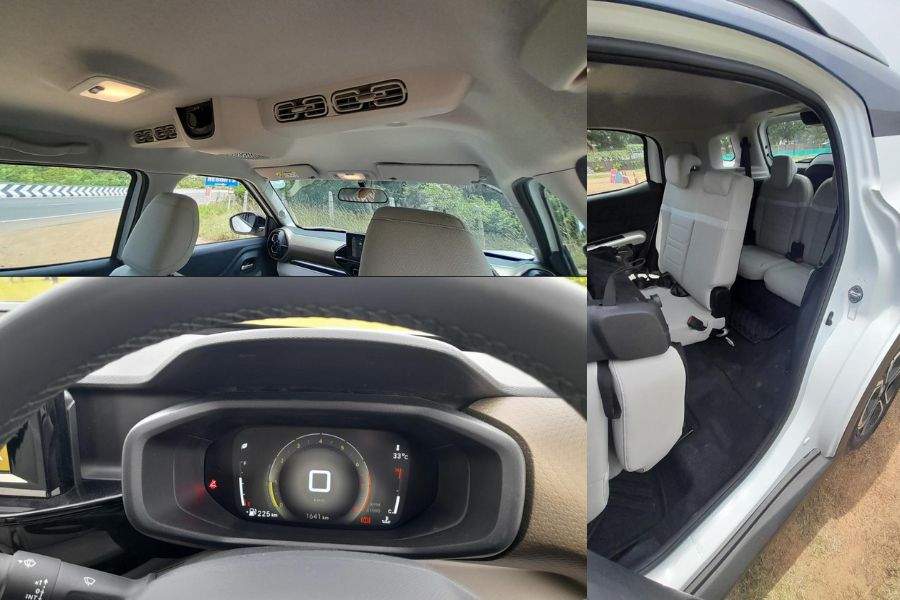A couple of months ago Citroen India unveiled its C3 Aircross SUV in New Delhi. It was a production-ready vehicle and not a concept. It was also the third vehicle on the company’s C-cubed platform, the previous ones being the C3 and the eC3. Citroen has invested a significant sum in India, but that is not just for vehicle production. Its operations include development centres and also a plant for making engines. Plus, it says it is willing to take things a bit slow if needed to set itself up in the Indian market and in the minds of the buyers. So, it is in no tearing hurry to achieve exponential growth or something, which is probably logical given that its current production capacity is 100,000 vehicles a year, which can be increased by adding shifts, etc.
Citroen seems to be playing the cost and value game. The C3 Aircross, for instance, say company spokespersons, was created after extensive clinics and has the features that customers want while not including those that they do not find very important. And that is how Citroen hopes to price it super competitively, with bookings set to open next month.
t2oS got to drive both the five- and seven-seater versions in the Chennai-Mahabalipuram area at the invitation of Citroen. Here are our impressions of the C3 Aircross.
THE EXTERIOR
The C3 Aircross shares the same vehicle platform as the C3 as well as part of its name, but it is a shade more than just the C3 with a longer wheelbase and two extra seats. While the looks are similar, the Aircross has been given the squarer and more broad-shouldered look that buyers supposedly want. The front end is now a little bit louder with a more pronounced lower air intake with garnishings and a generally wider shape overall. Whatever the logic is, it looks good enough to bring home to mother, or father, or spouse, or children... all of whom are supposed to fit comfortably into the seven-seater version with the longer wheelbase of this one compared to that of the C3 hatchback.
In profile, the C-pillar looks wider and there is a teeny-weeny little glass area for the third row of seats as well. Around the back, there are squarer tail lamp clusters of a funky design that continues to the side. The clusters are connected by a dark bar that make it look broad and break up the slabbiness of the tailgate as well. The Aircross also gets a new set of alloys of a neat design that enhances the looks in profile. There are roof rails on some models, but they are not load-bearing and meant only to make the SUV look better.
Looks wise, then, the C3 Aircross has its appeal. It is kind of funky and kind of butch but somehow mixes things up well and is not in-your-face in any aspect. We like.
THE INTERIOR
While Citroen calls the C3 a hatchback, the C3 Aircross isn’t. It is a midsize SUV and will be the latest entrant in a very tough segment of the market. The Aircross can be seen as a longer version of the C3 with both five-seat and seven-seat options. Unlike other seven-seater SUVs that have been derived from five-seater midsize ones, the seven-seater C3 Aircross is not longer than its five-seater version.
The body shell remains the same but Citroen designers have managed to pack in two removable seats — they can be taken out or installed in under a minute — into it. These are probably alright for children or adults of small build, but not bigger persons. And the broad C-pillar restricts most of the view out of the side. So it’s somewhat cooped up in there although there are two tiny glass panels behind the C pillar.
This third row of seats is the biggest thing that sets the C3 Aircross apart from the C3. Also, the seven-seater gets a second row of air-conditioner vents on the ceiling that the five-seater does not have.
Much of the rest of the interiors is a carryover from the C3 in terms of design and looks. Thankfully, the instrument cluster is different on this one. It is a neat piece of screen with graphics that look current, unlike that of the C3 that look a tad dated in today’s day and age. This new piece of kit should go a fair distance towards improving the perceived ownership experience.
There are a couple of things that Citroen could look into though. One is offering a couple of USB C ports that most gadgets nowadays use for charging. The C3 Aircross still has the old-school USBs.
The front seats have good bolstering but the middle and third row of seats are quite flat. But cushioning is good. Also, being flat, it should be more comfortable for the middle passenger in the second row too. We liked the overall design of the interiors when we drove the C3 earlier, stacked air-conditioner vents and all. And that liking remains. The infotainment system is much the same as the C3’s and supports most necessary connectivity features.
Oh, and this is a must-mention. The air-conditioner is fantastic. It cools the cabin in no time and even with temperatures outside in the high 30s Celsius, the C3 Aircross kept things very chilled out inside. Literally. We have been driving around in various cars and SUVs, and can say that this is one of the best we have come across for sure. What is even more commendable is that it is doing this cooling with an engine that’s not too big. Impressive.
ON THE ROAD
The C3 Aircross is powered by a 110hp, 1.2-litre, turbocharged 3-cylinder petrol that also does duty in the C3, but the naturally aspirated version with lower power output is not on offer, possibly keeping performance in mind. Talking of which, while not blisteringly fast, the C3 Aircross is still peppy enough for highway runs as we figured on the East Coast Road from Chennai to Puducherry.
Low-end torque is sufficient too and driving in narrower, more congested parts is also okay but it might take a couple of downshifts to keep the engine in the meaty part of the power band. The turbo kicks in very smoothly and there is no sudden surge of power or delay in delivery; the build-up is nice and linear. There is a low accompanying whistle from the turbocharger too.
The ride quality for a vehicle of this class is good indeed. And just so that we experience it first-hand, Citroen designed an off-road course that would test the vehicle’s suspension. This was a twisty piece of track that had all kinds of cambers and potholes and logs and dips and climbs and so on. It was kind of like an offroad test track 101 or maybe 102.
Even so, given that this is nowhere near a full-blown offroader or even a 4x4, it went around pretty well and also managed to insulate passengers quite a bit. We later tried the SUV out on some real-world agricultural roads and it did just fine. So, while people are most likely not going to go off-roading in them, the C3 Aircross seems to have the chops to get you out of some sticky situations at least. (For the rest, keep a tow rope handy.)
THE CALL
So, we come to the crucial question. As we said at the outset, Citroen seems to have designed the C3 Aircross keeping many things in mind and has essentially set it up for a set of people who are more keen on the essential features rather than having bells and whistles that will never be used. Citroen spokespersons have said that pricing will be extremely competitive. (“Wait for the price”, is what they actually said with a twinkle in the eye.)
So, yes, we think they are working to a plan. And while the Citroen C3 Aircross may not appeal to those who look for a very long feature list, it should to those to whom the usefulness of the features given matters. The crucial bit, the price, is still not out. So, we will wait to see if that works. We really like the ride though, and that air-conditioner is just too good.

(Clockwise from left) The significant changes in the profile are in and around the C-pillar; There’s a bit more agression in the front-end design with wider intakes and less rounded lines; Although familiar, the dashboard design still looks smart and The rear end makes the squared look pretty obvious

(Clockwise from left) The seven-seater version gets a second row of air-conditioner vents on the roof; While getting in and out of the third row of seats, which are totally removable, is not too difficult, they are best for children and The instrument cluster is new although most of the rest of the dashboard design is carried over from the C3











